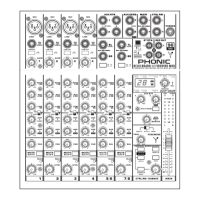6
HELIX BOARD 12 FIREWIRE MKII
MAKING CONNECTIONS
Inputs and Outputs
1. XLR Microphone Jacks
These jacks accept typical 3-
pin XLR inputs for balanced
and unbalanced signals.
They can be used in con-
junction with microphones
– such as professional con-
denser, dynamic or ribbon
microphones - with standard
XLR male connectors, and
feature low noise preampliers, serving for crys-
tal clear sound replication. The Helix Board 12
FireWire MKII mixers feature a total of four stan-
dard XLR microphone inputs.
NB. When these inputs are used with condenser
microphones, the Phantom Power should be activated.
However, when Phantom Power button is engaged, single
ended (unbalanced) microphones and instruments should
not be used on the Mic inputs.
2. Line Inputs
This input accepts typical 1/4” TRS or TS inputs,
for balanced or unbalanced signals. They can
be used in conjunction with various line level
devices, such as keyboards, drum machines,
electric guitars, and a variety of other electric
instruments.
3. Stereo Channels
The Helix Board 12 FireWire MKII
mixer features a couple of stereo
channels, thrown in for maximum
exibility. Each of these stereo
channels features two 1/4” TRS
phone jacks, for the addition of
various line level input devices,
such as electronic keyboards,
guitars and external signal
processors or mixers.
These Stereo Channels can also be used as
Mono channels, where the signal from any 1/4”
phone jack plugged into the Left stereo input
will be duplicated to the Right input due to the
miracle of jack normalizing (this does not work in
reverse, however).
4. Stereo AUX Return
These 1/4” TS inputs are for the return of audio
to the Helix Board 12 FireWire MKII mixer,
processed by an external signal processor. If
really needed, they can also be used as additional
stereo inputs, with a level control located on
the face of the mixer. The Stereo AUX Return
can also accept Mono signals, where plugging
the 1/4” phone jack of any device into the Left
input will cause the signal to be duplicated to the
Right input also (this does not work in reverse,
however). Signals processed by the built-in
digital effects processor are cut-off when any
1/4” phone jack is plugged into the AUX return 2.
5. AUX / Effects Send
These 1/4” TS outputs may be used to connect
to an external digital effect processor, or even to
an amplier and speakers (depending on your
desired settings), to the mixer. The AUX send is a
pre-fader signal, suitable for sending to monitors
to allow performers to monitor their music.
The EFX send signal is post-fader, suitable for
sending to external effect processors, and then
return back to the AUX returns.
6. Main L and R Outputs
These two ports will output the nal stereo
balanced line level signal sent from the main
mixing bus. The primary purpose of these jacks
is to send the main output to external devices,
which may include power ampliers (and in-turn,
a pair of speakers), other mixers, as well as a
wide range of other possible signal processors
(equalizers, crossovers, etcetera).
7. Control Room Outputs
These two 1/4” Phone Jack outputs feed the
signal altered by the Control Room / Submix
control on the face of the mixer. This output has
extensive use, as it can be used to feed the
signal from the mixer to an active monitor, for
the monitoring of the audio signal from within a
booth, among other possible uses.

